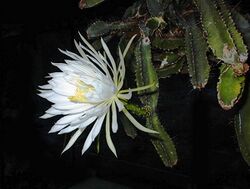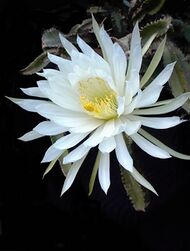Biology:Deamia testudo
| Deamia testudo | |
|---|---|

| |
| Scientific classification | |
| Kingdom: | Plantae |
| Clade: | Tracheophytes |
| Clade: | Angiosperms |
| Clade: | Eudicots |
| Order: | Caryophyllales |
| Family: | Cactaceae |
| Subfamily: | Cactoideae |
| Genus: | Deamia |
| Species: | D. testudo
|
| Binomial name | |
| Deamia testudo (Karw. ex Zucc.) Britton & Rose[1]
| |
| Synonyms[1] | |
| |
Deamia testudo is a species of flowering plant in the family Cactaceae, native from southern Mexico through Central America to Nicaragua.[1] It was first described in 1838.[2] It is a climber or clamberer, with long stems and large white flowers.
Description
Deamia testudo clambers over or hangs from rocks, or climbs or hangs from trees. It produces roots along its stems by which it clings tightly to its support. The stems are made up of segments up to 25 cm (10 in) long and 8 cm (3 in) in diameter. The stems usually have three ribs, although there may be up to eight. The ribs are thin and wing-like, about 1–3 cm (0.4–1.2 in) high. The areoles have up to 10 or more brownish spines, each 1–2 cm (0.4–0.8 in) long. The flowers have a long thin base and widely spread white tepals. Altogether the flower is about 25 cm (10 in) long and 15 cm (6 in) across.[3][4]

Taxonomy
The species was first described by Joseph Gerhard Zuccarini in 1838, as Cereus testudo. Zuccarini ascribed the scientific name to Wilhelm Friedrich Karwinsky.[5] In 1920, Nathaniel Lord Britton and Joseph Nelson Rose considered the species sufficiently distinctive to transfer it to their newly created genus Deamia, where it was the only species.[2] In 1965, Franz Buxbaum transferred it to the genus Selenicereus, based on its flowers, a view supported by Wilhelm Barthlott and David Hunt in 1993. In 2003, Ralf Bauer transferred it to the genus Strophocactus. Meanwhile, in 2002, Alexander Doweld had revived Deamia for both this species and another formerly placed in Selenicereus (Deamia chontalensis).[6] Molecular phylogenetic studies in 2017 and in 2018 confirmed the monophyly of the genus Deamia,[6][7] of which D. testudo is the type species.
Distribution
References
- ↑ 1.0 1.1 1.2 "Deamia testudo (Karw. ex Zucc.) Britton & Rose", Plants of the World Online (Royal Botanic Gardens, Kew), https://powo.science.kew.org/taxon/urn:lsid:ipni.org:names:77042-2, retrieved 2021-03-12
- ↑ 2.0 2.1 "Deamia testudo (Karw. ex Zucc.) Britton & Rose", The International Plant Names Index, http://www.ipni.org/ipni/idPlantNameSearch.do?id=77042-2, retrieved 2021-03-12
- ↑ Britton, N.L.; Rose, J.N. (1920), "5. Deamia gen. nov.", The Cactaceae Vol. 2, Washington, D.C.: The Carnegie Institution, p. 212–214, https://www.biodiversitylibrary.org/page/32089160, retrieved 2021-03-09
- ↑ Anderson, Edward F. (2001), "Selenicereus testudo", The Cactus Family, Pentland, Oregon: Timber Press, p. 636, ISBN 978-0-88192-498-5
- ↑ "Cereus testudo Karw. ex Zucc.", The International Plant Names Index, http://www.ipni.org/ipni/idPlantNameSearch.do?id=130756-1, retrieved 2021-03-12
- ↑ 6.0 6.1 Korotkova, Nadja; Borsch, Thomas; Arias, Salvador (2017), "A phylogenetic framework for the Hylocereeae (Cactaceae) and implications for the circumscription of the genera", Phytotaxa 327 (1): 1–46, doi:10.11646/phytotaxa.327.1.1, https://www.researchgate.net/publication/320829990
- ↑ Cerén, G.; Cruz, M.S.; Menjívar, J.; Arias, S. (2018), "A new species of Deamia (Cactaceae) from the Mesoamerican region", Phytotaxa 369 (4): 251–259, doi:10.11646/phytotaxa.369.4.2, https://www.researchgate.net/publication/327800432
Wikidata ☰ {{{from}}} entry
 |

